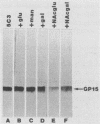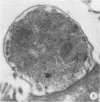Abstract
An immunoglobulin A monoclonal antibody (MAb5C3) was developed against a 15-kDa surface glycoprotein (GP15) of Cryptosporidium parvum sporozoites. Indirect immunofluorescence and colloidal gold immunoelectron microscopy revealed that the antibody reacted with both the sporozoite and merozoite surface plasma membranes. On Western immunoblots, MAb5C3 binding was found to be strongly inhibited when 200 mM N-acetylglucosamine was used as a competing sugar. N-Acetylgalactosamine inhibited binding of the antibody only slightly, whereas glucose, mannose, and galactose failed to inhibit binding. MAb5C3 was found to recognize a similar 15-kDa epitope associated with a Cryptosporidium sp. isolated from guinea pigs. However, MAb5C3 failed to react with any proteins or glycoproteins associated with C. baileyi from chickens, Cryptosporidium sp. (= bovine C. muris) from cattle, C. serpentis from a rat snake, bradyzoites of Besnoitia darlingi from an opossum, sporozoite/oocyst extracts of Caryospora bigenetica from an eastern diamondback rattlesnake, sporozoites of Eimeria nieschulzi and E. papillata from rats and mice, or tachyzoites of Toxoplasma gondii (RH strain). When hybridoma supernatants containing MAb5C3 were administered orally to suckling mice experimentally infected with C. parvum, a 75% reduction in developmental stages was seen histologically at 72 h postinfection and a 67.5% reduction in mean oocyst output was found at 6 days postinfection.
Full text
PDF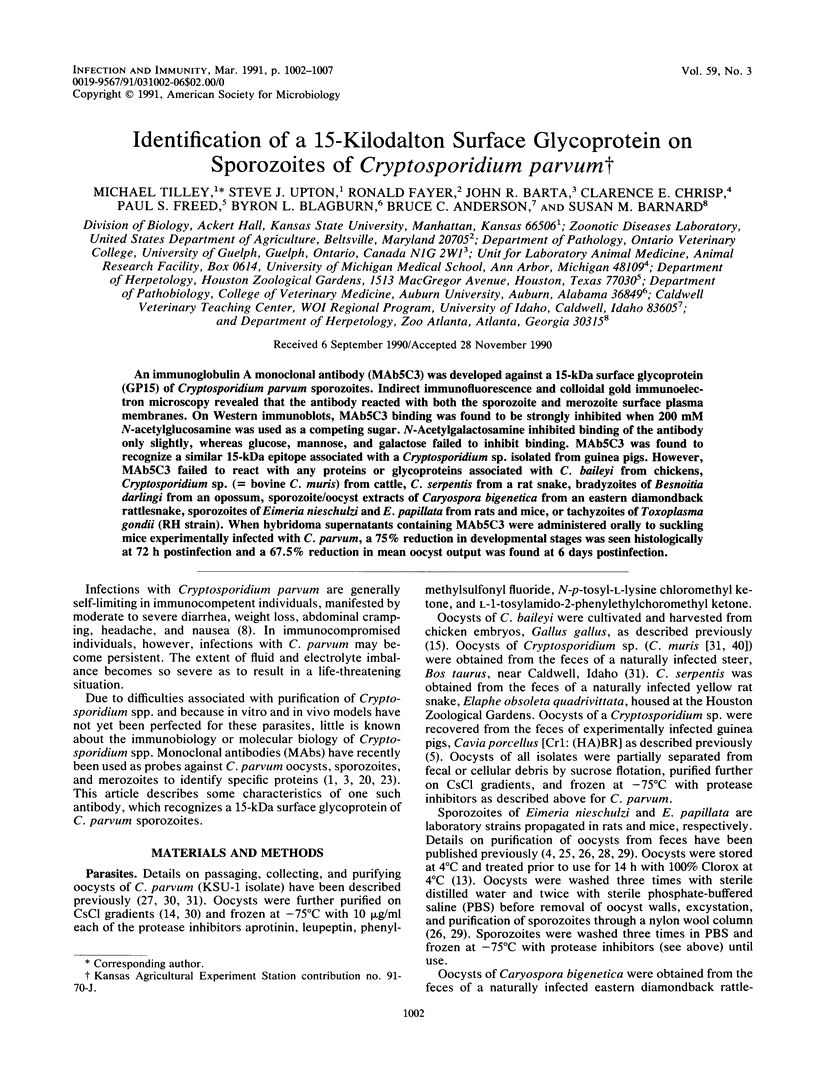
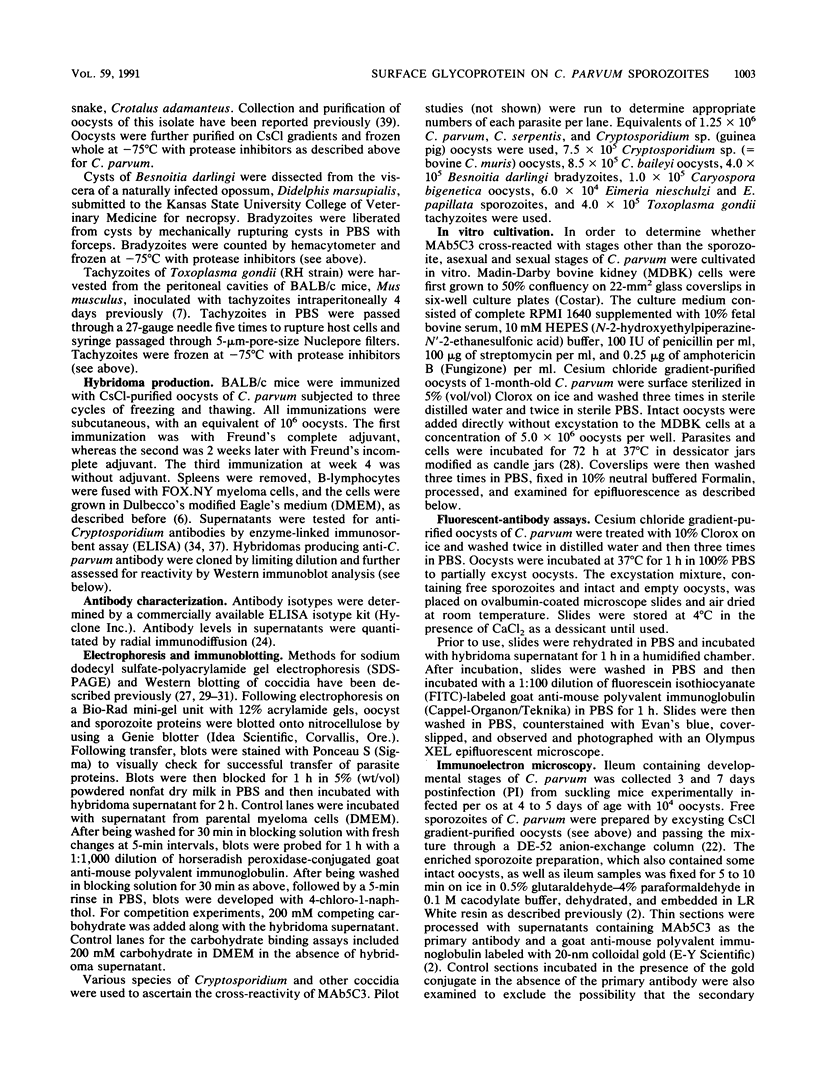
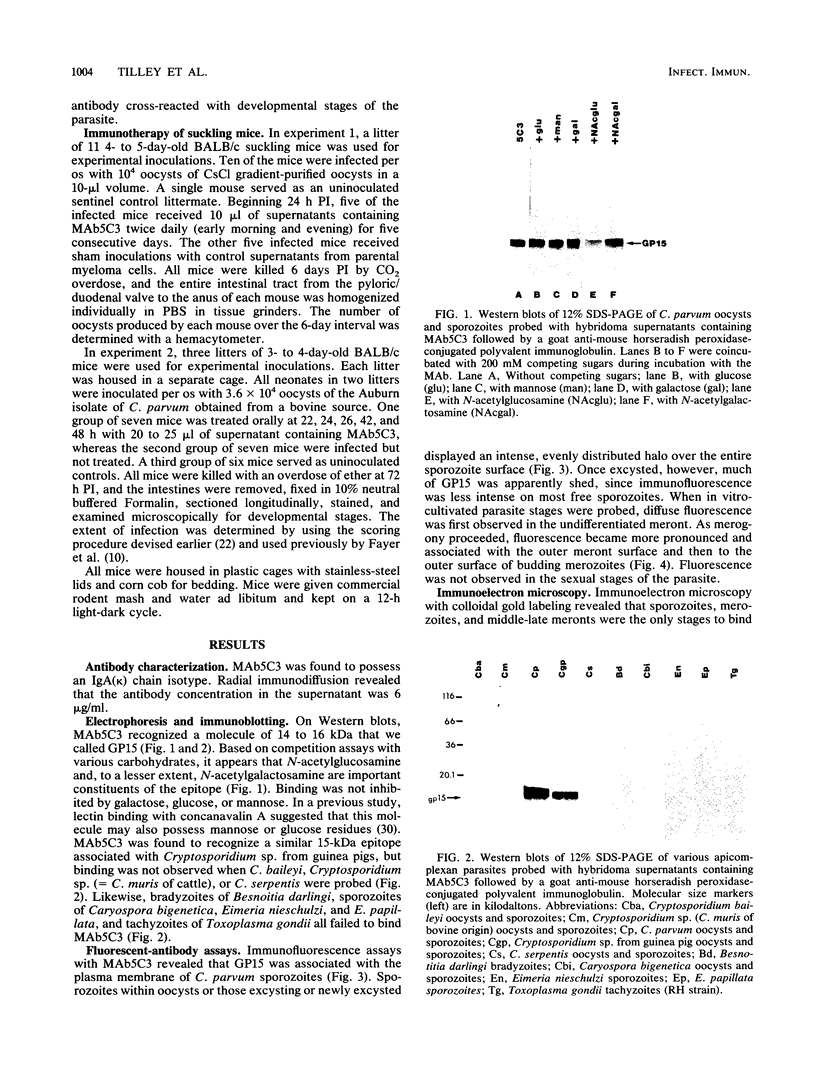


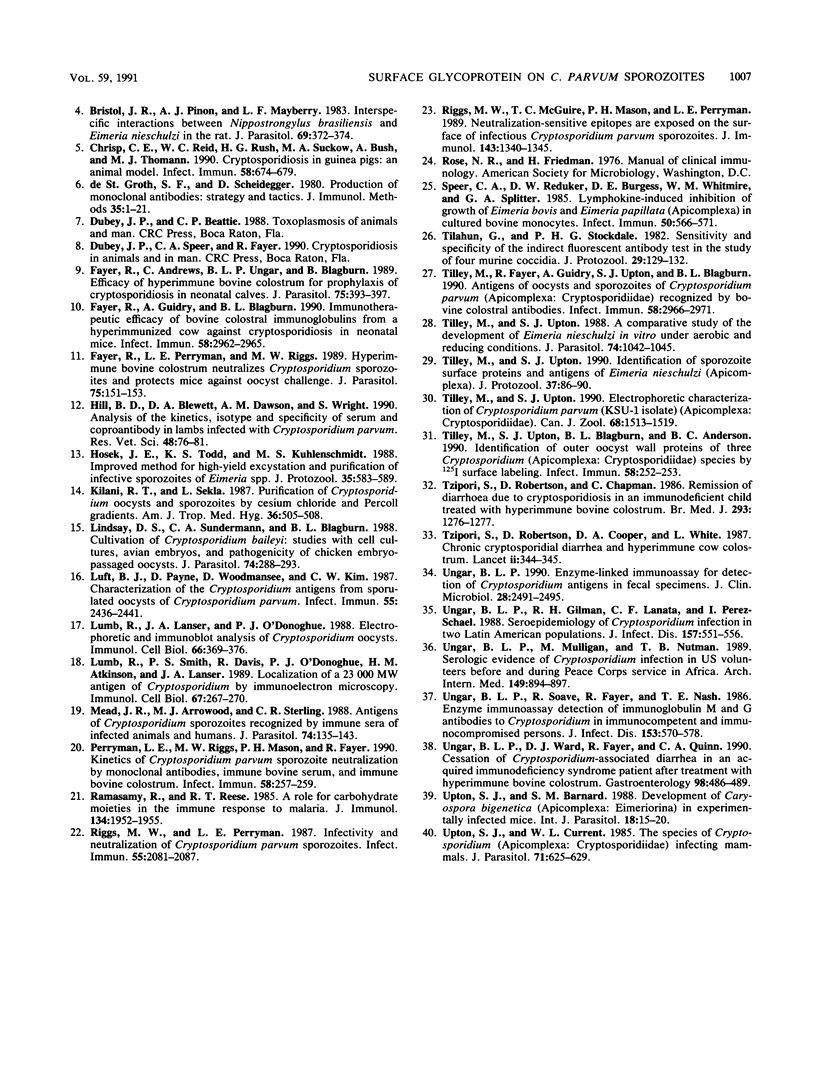
Images in this article
Selected References
These references are in PubMed. This may not be the complete list of references from this article.
- Arrowood M. J., Mead J. R., Mahrt J. L., Sterling C. R. Effects of immune colostrum and orally administered antisporozoite monoclonal antibodies on the outcome of Cryptosporidium parvum infections in neonatal mice. Infect Immun. 1989 Aug;57(8):2283–2288. doi: 10.1128/iai.57.8.2283-2288.1989. [DOI] [PMC free article] [PubMed] [Google Scholar]
- Barta J. R., Corbin J. Use of immunogold-silver staining to visualize antibody-antigen complexes on LR White embedded tissues prior to electron microscopy. J Electron Microsc Tech. 1990 Sep;16(1):83–84. doi: 10.1002/jemt.1060160111. [DOI] [PubMed] [Google Scholar]
- Bjorneby J. M., Riggs M. W., Perryman L. E. Cryptosporidium parvum merozoites share neutralization-sensitive epitopes with sporozoites. J Immunol. 1990 Jul 1;145(1):298–304. [PubMed] [Google Scholar]
- Bristol J. R., Piñon A. J., Mayberry L. F. Interspecific interactions between Nippostrongylus brasiliensis and Eimeria nieschulzi in the rat. J Parasitol. 1983 Apr;69(2):372–374. [PubMed] [Google Scholar]
- Chrisp C. E., Reid W. C., Rush H. G., Suckow M. A., Bush A., Thomann M. J. Cryptosporidiosis in guinea pigs: an animal model. Infect Immun. 1990 Mar;58(3):674–679. doi: 10.1128/iai.58.3.674-679.1990. [DOI] [PMC free article] [PubMed] [Google Scholar]
- Fayer R., Andrews C., Ungar B. L., Blagburn B. Efficacy of hyperimmune bovine colostrum for prophylaxis of cryptosporidiosis in neonatal calves. J Parasitol. 1989 Jun;75(3):393–397. [PubMed] [Google Scholar]
- Fayer R., Guidry A., Blagburn B. L. Immunotherapeutic efficacy of bovine colostral immunoglobulins from a hyperimmunized cow against cryptosporidiosis in neonatal mice. Infect Immun. 1990 Sep;58(9):2962–2965. doi: 10.1128/iai.58.9.2962-2965.1990. [DOI] [PMC free article] [PubMed] [Google Scholar]
- Fayer R., Perryman L. E., Riggs M. W. Hyperimmune bovine colostrum neutralizes Cryptosporidium sporozoites and protects mice against oocyst challenge. J Parasitol. 1989 Feb;75(1):151–153. [PubMed] [Google Scholar]
- Hill B. D., Blewett D. A., Dawson A. M., Wright S. Analysis of the kinetics, isotype and specificity of serum and coproantibody in lambs infected with Cryptosporidium parvum. Res Vet Sci. 1990 Jan;48(1):76–81. [PubMed] [Google Scholar]
- Hosek J. E., Todd K. S., Jr, Kuhlenschmidt M. S. Improved method for high-yield excystation and purification of infective sporozoites of Eimeria spp. J Protozool. 1988 Nov;35(4):583–589. doi: 10.1111/j.1550-7408.1988.tb04156.x. [DOI] [PubMed] [Google Scholar]
- Kilani R. T., Sekla L. Purification of Cryptosporidium oocysts and sporozoites by cesium chloride and Percoll gradients. Am J Trop Med Hyg. 1987 May;36(3):505–508. doi: 10.4269/ajtmh.1987.36.505. [DOI] [PubMed] [Google Scholar]
- Lindsay D. S., Sundermann C. A., Blagburn B. L. Cultivation of Cryptosporidium baileyi: studies with cell cultures, avian embryos, and pathogenicity of chicken embryo-passaged oocysts. J Parasitol. 1988 Apr;74(2):288–293. [PubMed] [Google Scholar]
- Luft B. J., Payne D., Woodmansee D., Kim C. W. Characterization of the Cryptosporidium antigens from sporulated oocysts of Cryptosporidium parvum. Infect Immun. 1987 Oct;55(10):2436–2441. doi: 10.1128/iai.55.10.2436-2441.1987. [DOI] [PMC free article] [PubMed] [Google Scholar]
- Lumb R., Lanser J. A., O'Donoghue P. J. Electrophoretic and immunoblot analysis of Cryptosporidium oocysts. Immunol Cell Biol. 1988 Oct-Dec;66(Pt 5-6):369–376. doi: 10.1038/icb.1988.48. [DOI] [PubMed] [Google Scholar]
- Lumb R., Smith P. S., Davies R., O'Donoghue P. J., Atkinson H. M., Lanser J. A. Localization of a 23,000 MW antigen of Cryptosporidium by immunoelectron microscopy. Immunol Cell Biol. 1989 Aug;67(Pt 4):267–270. doi: 10.1038/icb.1989.40. [DOI] [PubMed] [Google Scholar]
- Mead J. R., Arrowood M. J., Sterling C. R. Antigens of Cryptosporidium sporozoites recognized by immune sera of infected animals and humans. J Parasitol. 1988 Feb;74(1):135–143. [PubMed] [Google Scholar]
- Perryman L. E., Riggs M. W., Mason P. H., Fayer R. Kinetics of Cryptosporidium parvum sporozoite neutralization by monoclonal antibodies, immune bovine serum, and immune bovine colostrum. Infect Immun. 1990 Jan;58(1):257–259. doi: 10.1128/iai.58.1.257-259.1990. [DOI] [PMC free article] [PubMed] [Google Scholar]
- Ramasamy R., Reese R. T. A role for carbohydrate moieties in the immune response to malaria. J Immunol. 1985 Mar;134(3):1952–1955. [PubMed] [Google Scholar]
- Riggs M. W., McGuire T. C., Mason P. H., Perryman L. E. Neutralization-sensitive epitopes are exposed on the surface of infectious Cryptosporidium parvum sporozoites. J Immunol. 1989 Aug 15;143(4):1340–1345. [PubMed] [Google Scholar]
- Riggs M. W., Perryman L. E. Infectivity and neutralization of Cryptosporidium parvum sporozoites. Infect Immun. 1987 Sep;55(9):2081–2087. doi: 10.1128/iai.55.9.2081-2087.1987. [DOI] [PMC free article] [PubMed] [Google Scholar]
- Speer C. A., Reduker D. W., Burgess D. E., Whitmire W. M., Splitter G. A. Lymphokine-induced inhibition of growth of Eimeria bovis and Eimeria papillata (Apicomplexa) in cultured bovine monocytes. Infect Immun. 1985 Nov;50(2):566–571. doi: 10.1128/iai.50.2.566-571.1985. [DOI] [PMC free article] [PubMed] [Google Scholar]
- Tilahun G., Stockdale P. H. Sensitivity and specificity of the indirect fluorescent antibody test in the study of four murine coccidia. J Protozool. 1982 Feb;29(1):129–132. doi: 10.1111/j.1550-7408.1982.tb02895.x. [DOI] [PubMed] [Google Scholar]
- Tilley M., Fayer R., Guidry A., Upton S. J., Blagburn B. L. Cryptosporidium parvum (Apicomplexa: Cryptosporidiidae) oocyst and sporozoite antigens recognized by bovine colostral antibodies. Infect Immun. 1990 Sep;58(9):2966–2971. doi: 10.1128/iai.58.9.2966-2971.1990. [DOI] [PMC free article] [PubMed] [Google Scholar]
- Tilley M., Upton S. J. A comparative study of the development of Eimeria nieschulzi in vitro under aerobic and reducing conditions. J Parasitol. 1988 Dec;74(6):1042–1045. [PubMed] [Google Scholar]
- Tilley M., Upton S. J., Blagburn B. L., Anderson B. C. Identification of outer oocyst wall proteins of three Cryptosporidium (Apicomplexa: Cryptosporidiidae) species by 125I surface labeling. Infect Immun. 1990 Jan;58(1):252–253. doi: 10.1128/iai.58.1.252-253.1990. [DOI] [PMC free article] [PubMed] [Google Scholar]
- Tilley M., Upton S. J. Identification of sporozoite surface proteins and antigens of Eimeria nieschulzi (Apicomplexa). J Protozool. 1990 Mar-Apr;37(2):86–90. doi: 10.1111/j.1550-7408.1990.tb05875.x. [DOI] [PubMed] [Google Scholar]
- Tzipori S., Roberton D., Chapman C. Remission of diarrhoea due to cryptosporidiosis in an immunodeficient child treated with hyperimmune bovine colostrum. Br Med J (Clin Res Ed) 1986 Nov 15;293(6557):1276–1277. doi: 10.1136/bmj.293.6557.1276. [DOI] [PMC free article] [PubMed] [Google Scholar]
- Tzipori S., Roberton D., Cooper D. A., White L. Chronic cryptosporidial diarrhoea and hyperimmune cow colostrum. Lancet. 1987 Aug 8;2(8554):344–345. doi: 10.1016/s0140-6736(87)90944-5. [DOI] [PubMed] [Google Scholar]
- Ungar B. L. Enzyme-linked immunoassay for detection of Cryptosporidium antigens in fecal specimens. J Clin Microbiol. 1990 Nov;28(11):2491–2495. doi: 10.1128/jcm.28.11.2491-2495.1990. [DOI] [PMC free article] [PubMed] [Google Scholar]
- Ungar B. L., Gilman R. H., Lanata C. F., Perez-Schael I. Seroepidemiology of Cryptosporidium infection in two Latin American populations. J Infect Dis. 1988 Mar;157(3):551–556. doi: 10.1093/infdis/157.3.551. [DOI] [PubMed] [Google Scholar]
- Ungar B. L., Mulligan M., Nutman T. B. Serologic evidence of Cryptosporidium infection in US volunteers before and during Peace Corps service in Africa. Arch Intern Med. 1989 Apr;149(4):894–897. [PubMed] [Google Scholar]
- Ungar B. L., Soave R., Fayer R., Nash T. E. Enzyme immunoassay detection of immunoglobulin M and G antibodies to Cryptosporidium in immunocompetent and immunocompromised persons. J Infect Dis. 1986 Mar;153(3):570–578. doi: 10.1093/infdis/153.3.570. [DOI] [PubMed] [Google Scholar]
- Ungar B. L., Ward D. J., Fayer R., Quinn C. A. Cessation of Cryptosporidium-associated diarrhea in an acquired immunodeficiency syndrome patient after treatment with hyperimmune bovine colostrum. Gastroenterology. 1990 Feb;98(2):486–489. doi: 10.1016/0016-5085(90)90842-o. [DOI] [PubMed] [Google Scholar]
- Upton S. J., Barnard S. M. Development of Caryospora bigenetica (Apicomplexa: Eimeriorina) in experimentally infected mice. Int J Parasitol. 1988 Feb;18(1):15–20. doi: 10.1016/0020-7519(88)90030-6. [DOI] [PubMed] [Google Scholar]
- Upton S. J., Current W. L. The species of Cryptosporidium (Apicomplexa: Cryptosporidiidae) infecting mammals. J Parasitol. 1985 Oct;71(5):625–629. [PubMed] [Google Scholar]
- de StGroth S. F., Scheidegger D. Production of monoclonal antibodies: strategy and tactics. J Immunol Methods. 1980;35(1-2):1–21. doi: 10.1016/0022-1759(80)90146-5. [DOI] [PubMed] [Google Scholar]



